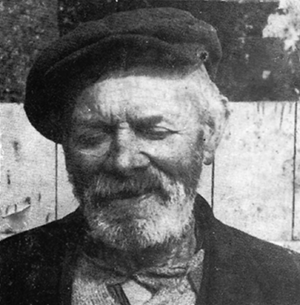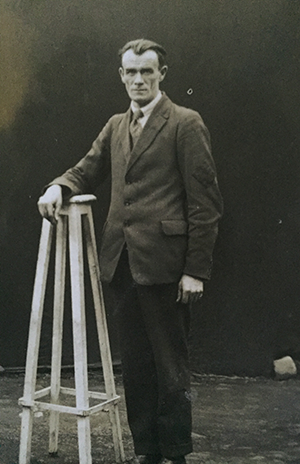Mickeen Cullens—Ireland’s forgotten hero of Messines
Published in Features, Issue 4 (July/August 2017), Volume 25A providential encounter and one of the most remarkable tales of Irish bravery in the First World War.
By Thomas Dillon
On a Belgian battlefield in June 1917, Mickeen Cullens from County Kerry defied military orders by stopping to save a wounded comrade. Though he risked being shot by his own side, he rescued Ballybunion’s Paddy Kennelly. Both men came from the same parish and knew each other at home. Their meeting was completely unexpected, however, as neither had any idea that the other was serving in the war, let alone in the same unit.
Background

Above: Mickeen Cullens—later in life he struggled with the mental trauma of his wartime service.
Kennelly shot from behind
Serving in the 1st Battalion, Royal Munster Fusiliers, the two Kerry men waited for action unwittingly close to each other on 7 June 1917, as nineteen mines, tunnelled deep beneath the German positions, were exploded to coincide with the start of the attack on the Messines-Wytschaete Ridge at 3.10am. Paddy Kennelly later recounted how the Munsters were ordered forward and charged the enemy lines in three waves with bayonets fixed. He took his place in the first wave and they advanced through a wood known as Bois de Wytschaete, where German snipers and hidden machine-guns fired on them from behind.
Kennelly was shot in the back and fell to the ground, dangerously wounded. Drifting in and out of consciousness through loss of blood, he firmly believed that he was going to bleed to death when all of a sudden he recognised a passing soldier. To his disbelief it was Mickeen Cullens, who was charging in the second wave. Kennelly called out to his equally astonished comrade and luckily attracted his attention.
The soldiers had been told before the battle that under no circumstances were they to stop to help the wounded. The momentum of the attack had to be maintained, and any man who defied that order risked being shot out of hand by his officer. Cullens saw that Kennelly was badly injured and, even at the cost of his own life and a dishonourable death, he resolved not to leave the 21-year-old to die. Tearing off his tunic and shirt, he knelt down and used them to stuff the wound in order to slow the bleeding. He then lifted Kennelly up across his shoulders and, with the added weight of his own pack and equipment, struggled across the broken ground, making sure to bring his rifle in case he was accused of deserting from the assault.
The bullets and shells were flying as Cullens made his way back to his own lines, carrying the Ballybunion man safely to a dressing station before returning to the fight. Normally, his remarkable feat of bravery would have merited an official commendation or medal, but since he had defied military orders it could not be brought to the attention of his commanders.
Often recalling his miraculous escape in later life, Paddy Kennelly revealed that it was still another hour before his wound was attended to by medics. His injury was serious but he recovered and went back to the war, serving in Italy, Egypt and the Holy Land.
IRA commander

Above: The man he saved at the Battle of Messines in June 1917—Paddy Kennelly of Ballybunion, who later became an IRA commander.
The pair remained firm friends and Kennelly regularly visited his former brother in arms. Spending much of his money and time in pubs, Cullens struggled with the mental trauma of his wartime service. The war was a subject he didn’t care to discuss. Having never married and with no family living nearby, Mickeen Cullens was a patient in the county home in Killarney when he passed away on 3 October 1956. He was buried in Lisselton churchyard in an unmarked grave. Like his brother Patrick, and countless others killed in the ‘war to end all wars’, no headstone marks the final resting place of this forgotten hero of Messines.
Thomas Dillon has an MA in History of the Family from the University of Limerick.
















